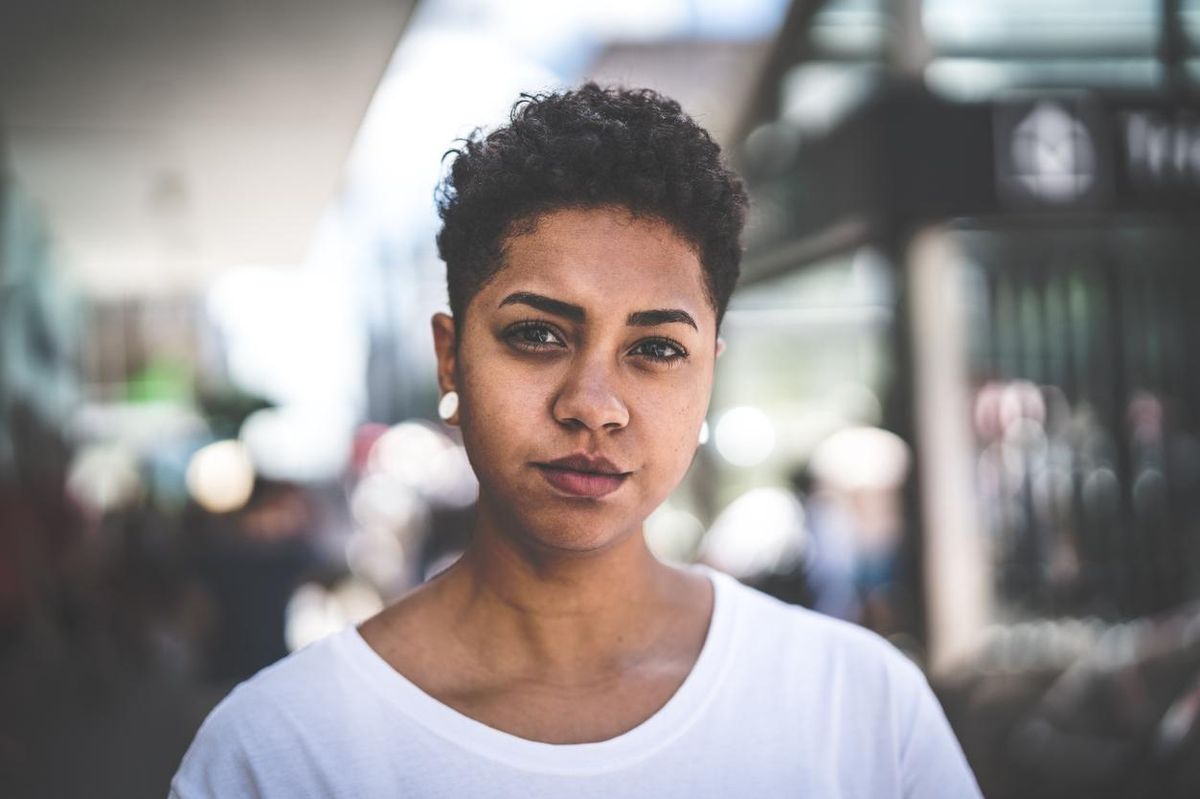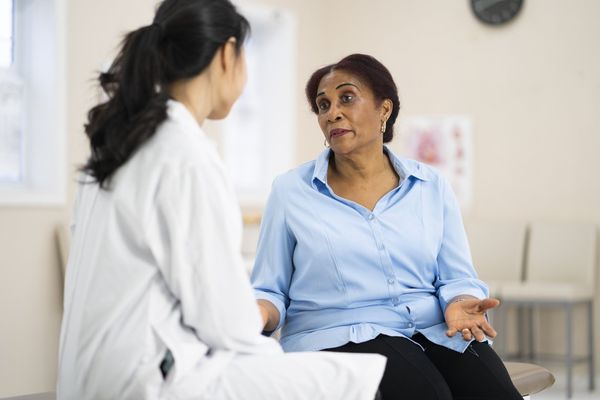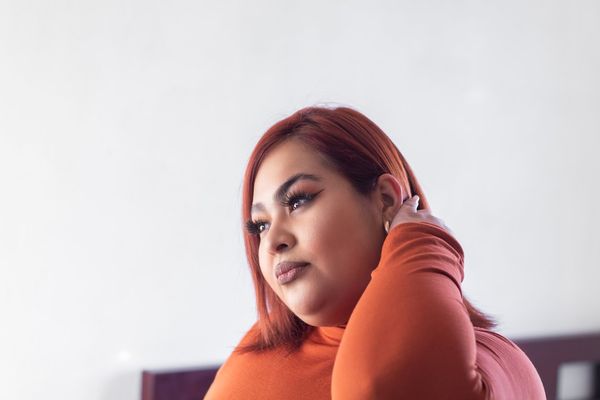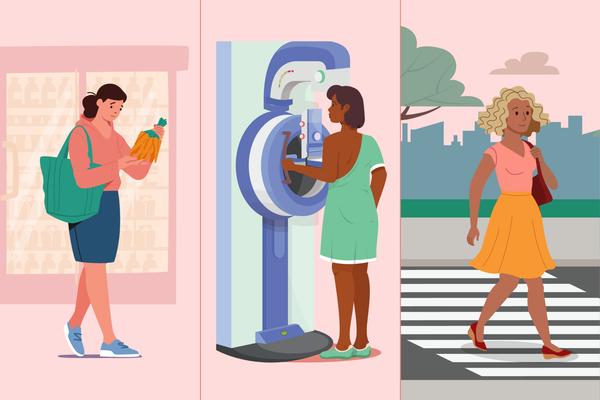In 2012, Adrienne Moore noticed her menstrual cycles were changing. Her periods were becoming irregular, and they came with heavy bleeding and significant cramping when they did arrive. Healthcare providers diagnosed cysts, fibroids and even early menopause, but Moore said no one presented a treatment plan that worked.
For the next four years, Moore searched for answers. She wondered if her condition was related to the ovarian cancer she survived in 2003, but the providers she visited didn’t investigate further. Moore also didn’t have insurance for a year, despite working as a respiratory therapist, because one employer offered a plan that she couldn’t afford, while another wouldn’t provide insurance until she completed a probationary period. She remained uninsured when she lost her job after her illness kept her from working, and family helped her pay directly for tests to try to figure out what was wrong.
In March 2016, after securing a job that offered insurance from the start, Moore saw a new provider who ordered a biopsy. The results finally gave her an answer: Moore had endometrial cancer, and at stage 3B, it had spread to the middle layer of her uterine wall.
“I was numb at first, then I was just angry,” she said. “I could have had a totally different outcome if this had been caught earlier. Why wasn’t anyone listening to me when I was telling them what was wrong? They gave me every explanation in the world other than [that] I might be at risk for another cancer.”
Endometrial cancer, or cancer of the lining of the uterus, is the most common reproductive organ cancer among women in the United States. The American Cancer Society estimates that 65,950 new cases of uterine cancer will be diagnosed in 2022, and 12,550 women will die from the disease. Endometrial cancer, a type of uterine cancer, is most commonly found in postmenopausal women, with 60 being the average age of diagnosis.
While endometrial cancer is uncommon in younger women, Moore was 40 years of age when she began experiencing the symptoms that were likely a sign that her cancer was developing. As she learned later, she had several factors that placed her at higher risk for endometrial cancer, including her past ovarian cancer diagnosis and a family history of colorectal cancer (cancer that begins in the colon or rectum), a disease that killed her father.
Being a Black woman also put Moore at greater risk of dying from endometrial cancer. As with many other conditions, women of color are more likely to die of endometrial cancer even though they have fewer diagnoses compared to white women.
“The inequities with endometrial cancer [have many different causes], including delayed diagnosis, sometimes due to disparities or inconsistencies in provider treatment and sometimes the patient’s underreporting of symptoms,” said Daihnia Dunkley, Ph.D., RN, an academic lecturer in the graduate entry prespecialty in nursing and master of science in nursing programs at the Yale School of Nursing and a member of the HealthyWomen Women’s Health Advisory Council. “Black women may endure symptoms due to medical mistrust or may normalize symptoms because of lack of knowledge.”
There are many reasons for that distrust. From the Tuskegee syphilis study to surveys indicating that healthcare providers believe Black patients have a higher pain threshold than white patients, Black patients in the U.S. have historically received medical care that is below standard. Higher rates of maternal mortality, premature births and hysterectomies as a first option for fibroid treatment are examples of the disparities Black women can face when seeking reproductive healthcare.
A study published in the Journal of the American Medical Association that interviewed 15 Black women with endometrial cancer suggested that various factors may contribute to a delay in diagnosis in the Black community. Participants described knowledge gaps about menopause, silence regarding vaginal bleeding among family and friends, misinterpretation of vaginal bleeding symptoms, and lack of dialogue with health care professionals. Black women may also have other conditions at the same time, such as Type 2 diabetes, that place them at higher risk for poor outcomes, Dunkley said. Biological and genetic differences could also be a factor, she said, since Black women with endometrial cancer are more likely to be diagnosed with rare and more aggressive forms of the disease.
Moore’s experience led her to become an ambassador for the Endometrial Cancer Action Network for African-Americans (ECANA) to reach other Black women battling endometrial cancer. She believes her story and those of other Black women survivors she meets highlight the disparities Black women can face in receiving proper treatment, from being able to afford healthcare insurance and treatment by specialists to dealing with potential bias from healthcare providers who aren’t addressing their concerns.
“This is why we need advocacy groups — so we’re not just being kicked off a cliff and being told to just go back to business,” Moore said. “As Black women, we have to have a community of ambassadors to talk about what reproductive health bias can do. We have to have hard discussions in our community because so many Black women are falling through the cracks and getting late-stage diagnoses. We need to know that menstrual cycles shouldn’t look like soaking through three pads in an hour, or being doubled over in pain and not being able to walk.”
Moore didn’t learn about the signs that should have alerted her healthcare providers to cancer, such as the increase in thickness of her endometrial lining, until she worked with ECANA. “No provider ever brought that up to me, ever,” she said.
Her past cancer diagnosis also should have been an immediate red flag, but the only connection anyone made to cancer was a suggestion that Moore’s abnormal cycles were a sign of early menopause brought on by her past chemotherapy treatments.
Now 50, Moore has been cancer-free for more than five years after undergoing a hysterectomy, pelvic radiation and chemotherapy. As an ECANA ambassador, Moore connects with Black women across her home state of Georgia, taking time to talk, share educational materials and participate in a “survivor’s sanctuary,” a twice-monthly gathering for yoga and conversation.
“We're all in different stages of our journey,” Moore said. “But most of us have the same stories of having heavy periods for months or years and being given the wrong diagnoses. The important thing is that we have a community who encourages us to continue to survive and thrive.”
References
https://batten.virginia.edu/about/news/black-americans-are-systematically-under-treated-pain-why
https://www.cancer.org/cancer/colon-rectal-cancer/about/what-is-colorectal-cancer.html
https://www.cancer.org/cancer/endometrial-cancer/causes-risks-prevention/risk-factors.html
https://www.ncbi.nlm.nih.gov/labs/pmc/articles/PMC5829000/
https://pubmed.ncbi.nlm.nih.gov/32109459/
This resource was created with funding and support from Eisai Inc.
- Let’s Talk About Endometrial Cancer ›
- Clinically Speaking: Questions to Ask Your HCP About Endometrial Cancer ›
- Let’s Talk About Endometrial Cancer - HealthyWomen ›
- Postmenopausal Women and Endometrial Cancer - HealthyWomen ›
- Mujeres posmenopáusicas y el cáncer endometrial - HealthyWomen ›
- My Endometrial Cancer Was Dismissed as Fibroids - HealthyWomen ›
- Descartaron mi cáncer endometrial porque lo confundieron con fibromas - HealthyWomen ›
- Why Are Endometrial Cancer Rates Rising? - HealthyWomen ›
- My Endometrial Cancer Hid in Menopause - HealthyWomen ›
- ¿Por qué están aumentando las tasas de cáncer endometrial? - HealthyWomen ›
- Mi cáncer endometrial se mantuvo oculto durante la menopausia - HealthyWomen ›
- Endometrial Cancer Diagnosis and Endometrial Cancer Test - HealthyWomen ›
- Diagnóstico y pruebas del cáncer endometrial - HealthyWomen ›
- I Was Told I Was Too Young to Have Endometrial Cancer - HealthyWomen ›
- Me dijeron que era demasiado joven para tener cáncer endometrial - HealthyWomen ›





